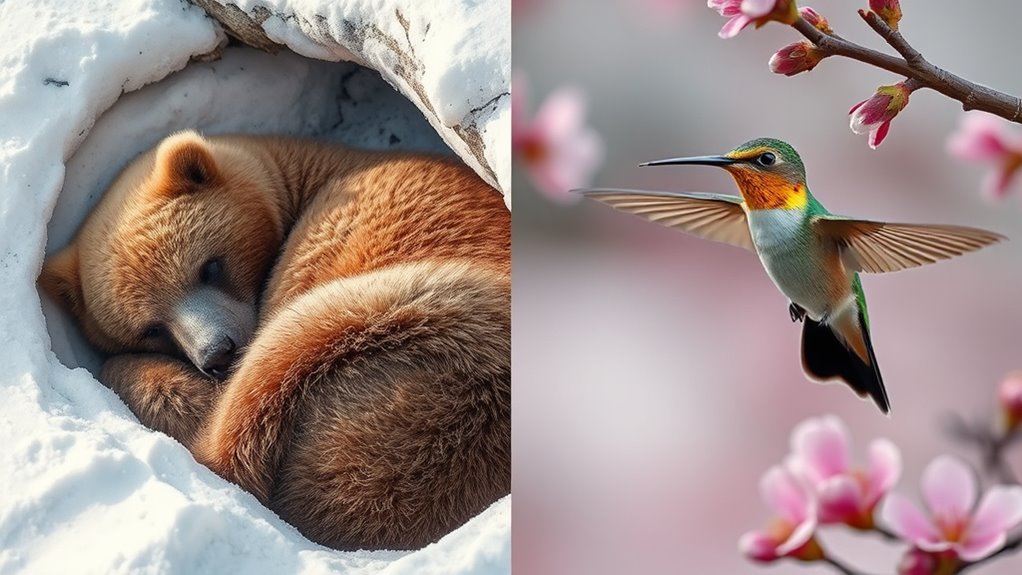Hibernation and torpor are distinct survival strategies animals use to withstand extreme conditions. Hibernation is a long-term state of dormancy lasting weeks or months, with a significant drop in metabolic rates and body temperature, conserving energy through fat reserves. In contrast, torpor is a short-term adjustment lasting hours or overnight, where metabolic rates decrease but body temperature remains above ambient levels. This allows quick resumption of normal activity. There’s even more to explore about these fascinating adaptations.
Key Takeaways
- Hibernation is a prolonged state lasting weeks or months, while torpor is a short-term state lasting hours or overnight.
- During hibernation, metabolic rates and body temperature drop significantly, while in torpor, they decrease but remain above ambient levels.
- Hibernation allows animals to survive without eating by relying on fat reserves, whereas torpor conserves energy during short, harsh conditions.
- Animals in hibernation experience a drastic slowdown in heart rate and breathing, unlike those in torpor who can wake quickly.
- Hibernation serves as a long-term survival strategy, while torpor offers daily adaptability and flexibility in response to environmental changes.

When winter’s chill sets in, you might wonder how some animals survive the harsh conditions. You may have heard of hibernation and torpor, but what’s the real difference between the two? These fascinating survival strategies allow animals to cope with cold temperatures and food scarcity, but they operate quite differently when it comes to metabolic rate and temperature regulation.
Hibernation is a prolonged state of dormancy that some animals—like bears and ground squirrels—enter during the cold months. When they hibernate, their metabolic rate drops markedly, allowing them to conserve energy. This decrease in activity means their bodies use stored fat more efficiently. During hibernation, an animal’s heart rate and breathing slow down, and its body temperature can drop to near ambient levels. This drastic temperature regulation helps them survive for months without eating, as they rely on their fat reserves to get through until spring.
On the other hand, torpor is a short-term state of decreased physiological activity. Animals that use torpor, such as certain bird species and small mammals, can enter this state on a daily basis. Unlike hibernation, which lasts for weeks or months, torpor can last only for a few hours or overnight. During torpor, an animal’s metabolic rate drops, but not to the same extreme level as in hibernation. This allows them to save energy during particularly cold nights or when food is scarce, without committing to a long-term dormancy.
Torpor allows animals to save energy daily, providing a brief respite from harsh conditions without long-term dormancy.
Temperature regulation in torpor is also less drastic. The animal’s body temperature lowers, but it typically remains higher than the ambient temperature. This quick adjustment helps them conserve energy while still being able to awaken quickly if conditions improve. When the sun rises or temperatures become more favorable, these animals can easily return to their normal activities, hunting or foraging for food. Interestingly, similar to how air purifiers enhance overall well-being, these survival strategies help animals maintain their health during extreme conditions.
Frequently Asked Questions
Do All Animals Experience Hibernation or Torpor?
Not all animals experience hibernation or torpor. Only certain species, like bears and bats, undergo hibernation for long periods, focusing on energy conservation during harsh conditions. Others, like some birds and small mammals, enter torpor, which involves a temporary metabolic slowdown, allowing them to save energy overnight or during short-term stress. So, while these strategies help many animals survive, they’re not universal across the animal kingdom.
Can Humans Enter a State Similar to Hibernation?
You might be surprised to know that while humans can’t fully hibernate, they can enter states of metabolic slowdown, similar to it. Think about how you feel after a long, restful sleep; your body conserves energy, adapting to low activity. Some researchers explore how extreme conditions, like fasting or deep sleep, trigger these responses. So, while you won’t curl up for months like a bear, your body certainly knows how to conserve energy when needed!
How Do Climate Changes Affect Hibernation Patterns?
Climate changes can markedly alter hibernation patterns for many animals. As temperatures rise and seasonal shifts occur, you’ll notice species adapting their hibernation schedules, sometimes waking earlier or delaying their hibernation altogether. This adaptation helps them cope with changes in food availability and environmental conditions. If these patterns continue to shift, it could disrupt ecosystems, affecting not just hibernators but also the species that rely on them for balance in their habitats.
Are There Health Risks Associated With Hibernation in Animals?
Yes, there are health risks associated with hibernation in animals. During this metabolic slowdown, their bodies conserve energy, but it can also lead to immune suppression. If the animal’s immune system weakens too much, it becomes vulnerable to infections and diseases. Additionally, prolonged hibernation can result in muscle atrophy and organ stress. So, while hibernation is essential for survival, it’s vital to monitor the health of animals during this period.
What Triggers an Animal to Enter Torpor?
When nature whispers its secrets, you’ll find animals slipping into torpor. This state is triggered by environmental cues like temperature drops and food scarcity. As the chill sets in, their metabolic rate slows, allowing them to conserve energy. It’s a clever survival tactic, letting them ride out tough conditions without depleting their resources. So, when you see the world changing, remember, some creatures are just tuning down for a bit!
Conclusion
So, while you might think hibernation and torpor are just fancy words for a long nap, they’re actually quite different! Hibernation is a deep, extended sleep meant for survival, while torpor is like a quick power nap for energy conservation. Ironically, animals have mastered the art of snoozing to thrive, while we humans just hit the snooze button and hope for the best. Maybe it’s time to take a cue from nature and learn the true meaning of rest!










